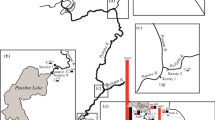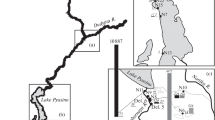Abstract
Studying bottom sediments of the Norilsk–Pyasina water system (July 29–August 13, 2020) showed that water pollution caused by an accidental spill at HPP-3 PJSC “MMC “Norilsk Nickel” on May 29, 2020, had propagated downstream the river over 31 km and had not reached Lake Pyasino and, the more so, the Kara Sea. The mean concentration of aliphatic hydrocarbons in sediments decreased in the series, µg/g: the mouth of the Ambarnaya R. (1914, σ = 3428) > the Bezymyannyi Cr.–the Daldykan R.–the Ambarnaya R. (1000, σ = 1351) > the Pyasina R. (27, σ = 17) > Lake Pyasino (15, σ = 6). The composition of aliphatic hydrocarbons in bottom sediments did not correspond to the hydrocarbon composition of diesel fuel even in the most heavily polluted regions because of transformations of alkanes. The concentrations of polycyclic aromatic hydrocarbons also rapidly decreased with the distance from the pollution source (from 3865 to 56 ng/g). At the same time, naphthalene (indicator of petroleum origin of hydrocarbons) accounted for 46–53% of the total. Naphthalene dominated in precipitation not only in the Ambarnaya and Daldykan rivers, but also the Norilka R. and the mouth of the Pyasina R., which may be due to other sources of soil pollution (erosion of coastal deposits, spent barrels of petroleum, oil, and lubricants, water transport, etc).







Similar content being viewed by others
REFERENCES
Bellami, L., IK-spektry slozhnykh molekul (IR-Spectra of Complex Molecules), Moscow: IL, 1963.
Bellami, L., Novye dannye po IK-spektram slozhnykh molekul (New Data on IR-Spectra of Complex Molecules), Moscow: Mir, 1971.
Glyaznetsova, Yu.S. and Nemirovskaya, I.A., Features of bitumoid distribution in bottom sediments of the Barents Sea, Oceanology, 2020, no. 6, pp. 831–839.
Diagnosticheskii analiz sostoyaniya okruzhayushchei sredy arkticheskoi zony Rossiiskoi Federatsii (rasshirennoe rezyume) (Diagnostic Analysis of the Environmental Conditions in the Arctic Zone of the Russian Federation (Extended Summary), Moscow: Nauch. mir, 2011.
Ivanov, D.V., Valiev, V.S., and Shagidullin, R.R., Statistical approach to determining regional background concentrations of petroleum hydrocarbons in bottom sediments, Tr. KarNTs RAN, 2020, no. 9, pp. 30–39.
Izrae’, Yu.A. and Tsyban’, A.V., Antropogennaya ekologiya okeana (Anthropogenic Ecology of the Ocean), Moscow: Nauka, 2009.
Il’inskii, V.V. and Semenenko, M.N., Occurrence and activity of hydrocarbon-oxidizing bacteria in the Kara and White seas, Opyt sistemnykh okeanologicheskikh issledovanii v Arktike (Experience of System Oceanological Studies in the Arctic), Moscow: Nauch. mir, 2001, pp. 364–375.
Kachestvo morskikh vod po gidrokhimicheskim pokazatelyam. Ezhegodnik 2019 g. (Seawater Quality by Hydrochemical Characteristics. 2019 Yearbook), Korshenko, A.N, Ed., Moscow: Nauka, 2020.
Monitoring Usinskoi katastrofy (Monitoring the Usinskaya Catastrophe). https://innoter. com/articles/monitoring-usinskoy-katastrofy. Cited January 8, 2022.
Nemirovskaya, I.A., Neft’ v okeane (zagryaznenie i prirodnye potoki) (Oil in the Ocean (Pollution and Natural Flows)), Moscow: Nauch. mir, 2013.
Nemirovskaya, I.A., Khramtsova, A.V., Khalikov, I.S., et al., Hydrocarbons in the water and sediments of the Norwegian and Barents seas, Tr. KarNTs RAN, no. 4, 2021, pp. 1–14.
Patin, S.A., Neft’ i ekologiya kontinental’nogo shel’fa (Oil and the Ecology of Continental Shelf), Moscow: VNIRO. 2017, vol. 1.
Patin, S.A., Neftyanye razlivy i ikh vozdeistvie na morskuyu sredu i bioresursy (Oil Spills and Their Effect on the Marine Environment and Bioresources), Moscow: VNIRO, 2008.
Pikovskii, Yu.I., Prirodnye i tekhnogennye potoki uglevodorodov v okruzhayushchei srede (Natural and Technogenic Flows of Hydrocarbons in the Environment), Moscow: Mosk. Gos. Univ., 1993.
Stolyarov, B.V., Savinov, I.M., and Vitenberg, A.G., Rukovodstvo k prakticheskim rabotam po gazovoi khromatografii: Ucheb. posobie dlya vuzov (Guide for Practical Works on Gas Chromatography: A Textbook for Higher Education), Leningrad: Khimiya, 1988.
Taran, O.P., Skripnikov, A.M., Ionin, V.A., et al., The composition and concentration of hydrocarbons of bottom sediments in the zone of diesel fuel spill at HPP-3 JSC NTEK (Noril’sk C., Arctic Siberia), Sib. Ekol. Zh., 2021, no. 4, pp. 423–450.
Troshko, K.A., Denisov, P.V., Lavrova, O.Yu., et al., Observations of Ambarnaya R. pollution resulting from an accident at HPP-3 in Noril’sk on May 29, 2020, Sovrem. Probl. Distants. Zond. Zemli Kosm., 2020, vol. 17, no. 3, pp. 267–274.
Uspenskii, V.A., Radchenko, O.A., Gorskaya, A.I., and Shishkova, A.P., Metody bituminologicheskikh issledovanii (Methods of Bituminological Studies), Leningrad: Nedra, 1975.
Khaustov, A.P. and Redina, M.M., Geochemical markers based on concentration ratios of PAH in oils and oil-polluted areas, Geochem. Int., 2017, no. 1, pp. 98–107.
Khoroshavin, V.Yu. and Moiseenko, T.I., Petroleum hydrocarbon runoff in rivers flowing from oil-and-gas-producing regions in Northwestern Siberia, Water Resour., 2014, vol. 41, no. 5, pp. 532–543.
Yablokov, A.M., Accident near Usinsk, Ekol. Monit., 1995, no. 1, pp. 8–10.
AMAP (Arctic Monitoring and Assessment Programme), Pt. 4, Sources, Inputs and Concentrations of Petroleum Hydrocarbons, Polycyclic Aromatic Hydrocarbons, and other Contaminants Related to Oil and Gas Activities in the Arctic, Oslo, 2007.
AMAP (Arctic Monitoring and Assessment Programme): Chemicals of Emerging Arctic Concern, 2016, Oslo, 2017.
Bioremediation of Petroleum Hydrocarbons in Cold Regions, Dennis M. Filler, Ian Snape, and David L. Barnes, Eds., Cambridge: Cambridge Univ. Press, 2008.
Camenzuli, D. and Freidman, B.L., On-site and in situ remediation technologies applicable to petroleum hydrocarbon contaminated sites in the Antarctic and Arctic, Polar Res., 2015, vol. 34, p. 24492. https://doi.org/10.3402/polar.v34.24492
Dahle, S., Savinov, V., Petrova, V., et al., Polycyclic aromatic hydrocarbons (PAHs) in Norwegian and Russian Arctic marine sediments: concentrations, geographical distribution and sources, Norw. J. Geol., 2006, vol. 86, no. 1, pp. 41–50.
Fernandes, M.B. and Sicre, M.A., Polycyclic aromatic hydrocarbons in the Arctic: Ob and Yenisei estuaries and Kara Sea shelf, Estuarine, Coastal Shelf Sci., 1999, vol. 48, pp. 725–737.
Fingas, M. and Brown, C.E., A review of oil spill remote sensing, Sensors, 2018, vol. 18, no. 1, p. 91. https://doi.org/10.3390/s18010091
Lifshits, S., Glyaznetsova, Y., Erofeevskaya, L., Chalaya, O., and Zueva, I., Effect of oil pollution on the ecological condition of soils and bottom sediments of the arctic region (Yakutia), Environ. Pol., 2021, vol. 288, p. 117680. https://doi.org/10.1016/j.envpol.2021.117680
Margesin, R. and Schinner, F., Biodegradation and bioremediation of hydrocarbons in extreme environments, Appl. Microbiol. Biotechnol., 2001, vol. 56, nos. 5−6, pp. 650–663. https://doi.org/10.1007/s002530100701
Monitoring of hazardous substances in the White Sea and Pechora Sea: harmonisation with OSPAR’s Coordinated, Environ. and Monitoring, Program (CEMP), Tromsø: Akvaplan-niva, 2011.
Morales-Caselles, C., Yunker, M.B., and Ross, P.S., Identification of spilled oil from the MV Marathassa (Vancouver, Canada 2015) Using Alkyl PAH Isomer Ratios, Arch. Environ. Contam. Toxicol., 2017, pp. 118–130.
Nemirovskaya, I.A. and Khramtsova, A.V., Features of the hydrocarbon distribution in the bottom sediments of the Norwegian and Barents seas, Fluids (MDPI), 2021, vol. 6. 456. https://doi.org/10.3390/fluids6120456
Page, C.A., Bonner, J.S., Sumner, P.L., and Autenrieth, R.L., Solubility of petroleum hydrocarbons in oil/water systems, Mar. Chem., 2000, vol. 70, pp. 79–87.
Peters, K.E., Walters, C.C., and Moldowan, J.M., The biomarker guide: V. 1. Biomarkers and isotopes in the environment and human history, Cambridge: University Press, Geological Magazine, 2006, vol. 143, no. 2, pp. 249–250.
Savinov, V.M., Savinova, T.M., Carrol, J., Matishev, G., Dahle, S., and Naes, K., Polycyclic Aromatic Hydrocarbons (PAHs) in sediments of the White Sea, Russia, Mar. Poll. Bull., 2000, vol. 40, no. 10, pp. 807–818.
Tolosa, I., Mora, S., Sheikholeslami, M.R. et al., Aliphatic and aromatic hydrocarbons in coastal Caspian Sea sediments, Mar. Pollut. Bull., 2004, vol. 48, pp. 44–60.
Wang, Z. and Fingas, M.F., Development of oil hydrocarbon fingerprinting and identification techniques, Mar. Poll. Bull., 2003, vol. 47, no. 3, pp. 423–452.
Yunker, M.B., Macdonald, R.W., Ross, P.S. et al., Alkane and PAH provenance and potential bioavailability in coastal marine sediments subject to a gradient of anthropogenic sources in British Columbia, Canada, Org. Geochem., 2015, no. 89–90, pp. 80–116.
Funding
The results of the study were obtained under governmental orders (project 122011200369-1) using the scientific equipment of the Center for Collective Use of the FRC YSC SB RAS within the framework of grant no. 13.TsKP.21.0016 with financial support of JSC Norilsk-Taimyr Power Company, contract 223-EP-2020/08 with SB RAS; the analyses were made under the Governmental Order of the RF Ministry of Education and Science, subject FMWE-2021-0006; the preparation for publication was supported by the Russia Science Foundation, project 19-17-00234-P.
Author information
Authors and Affiliations
Corresponding authors
Additional information
Translated by G. Krichevets
Rights and permissions
About this article
Cite this article
Nemirovskaya, I.A., Glyaznetsova, Y.S. The Effect of Accidental Spill of Diesel Fuel in Noril’sk on Hydrocarbon Concentrations and Composition in Bottom Sediments. Water Resour 49, 1027–1039 (2022). https://doi.org/10.1134/S0097807822060100
Received:
Revised:
Accepted:
Published:
Issue Date:
DOI: https://doi.org/10.1134/S0097807822060100




